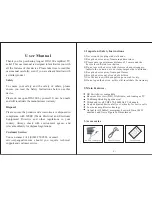
2 / 26
●
Under no circumstances install antennas in the vicinity of overhead power cables, otherwise the absolutely essen-
tial clearance requirements may no longer be satisfi ed. Maintain a clearance of at least 1 m from all other electrical
devices in all directions!
If you or metal parts of the antenna touch any electrical device there is a serious risk of a fatal electric
shock!
●
Never work on antenna systems during a thunderstorm or when a thunderstorm is approaching.
There is a risk of a fatal electric shock!
●
Never install antennas on buildings with easily fl ammable roof coverings such as straw, reeds or similar materials!
Otherwise there is a risk of fi re due to atmospheric over-voltages (static charges) or lightning discharges
(e.g. during thunderstorms).
●
The installation operations described here assume good craftsmanship capabilities and knowledge of the behaviour
of materials under the eff ects of wind. Therefore if you do not possess the required skills, have this work performed
by a specialist.
●
The person doing the work must wear strong non-slip footwear, must not be liable to dizziness, must be able to
move around safely on the roof and have a secure standing and attachment position (if necessary, wear a safety
harness when on the roof).
●
Make sure that the roof is able to bear your weight. Never walk on fragile or unstable surfaces! In case of doubt,
contact a qualifi ed specialist dealer or specialist roofi ng contractor to fi nd an appropriate installation location.
●
Do not go on to roofs or other high places without a correctly attached safety harness that is in good condition.
Otherwise use a work platform.
●
Ladders or other means of climbing must be in faultless condition (dry, clean and non-slip). Never build any
irresponsible “scrambling towers”!
●
If there is a risk that passers-by may be injured by items falling from above during installation, you must close off
the risk area using barriers! Make sure that no-one is underneath the installation location.
Risk of death or injury due to falling from the roof, falling through the roof and falling parts, plus the
possibility of damage to the roof.
●
The respective national safety regulations and current standards such as DIN EN 60728-11 should be complied with.
●
Any other use or failure to comply with these instructions will result in voiding of warranty coverage.
Basic Safety Instructions
Before you install, connect or use the parabolic antenna,
make sure that you comply with the instructions in this manual
!
If you disregard these instructions,
●
malfunctions may arise, creating
risks
to your life and health,
●
defects in the installation or the connection may cause
damage
to the antenna or to the attachment point,
●
the manufacturer will
not accept liability
for malfunctions and damage arising!
When working on antenna systems, please remember your
duty of care towards your fellow human beings
!
Keep the manual for any questions that arise later, and if the building passes to another owner, pass it on to the new owner!
●
Do not undo the cable tie on the carrier arm until you have swung out the boom and secured it
using the two M6 bolts (see section “Installing the antenna” item c “Installing the carrier arm”).
This is so as to prevent the boom swinging out during transport of the carrier arm. For this reason,
always carry the carrier arm as show in the illustration on the right.
This is to avoid the risk of injury by pinching!



































